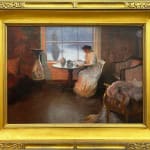

William Worcester Churchill American, 1858-1926
A Quiet Afternoon, circa 1900
Oil on canvas
20 1/8 x 28 1/8 inches
Signed lower left
Sold
Born in Jamaica Plain, Massachusetts, William Worcester Churchill entered the inaugural class at the Museum of Fine Arts School in Boston in 1877 along with Edward H. Barnard and Charles...
Born in Jamaica Plain, Massachusetts, William Worcester Churchill entered the inaugural class at the Museum of Fine Arts School in Boston in 1877 along with Edward H. Barnard and Charles Henry Hayden. There he studied drawing with Edwin Graves Champney, anatomy with William Rimmer, and painting with Otto Grundmann, who subsequently taught notables Edmund Tarbell and Frank Benson. From 1878 to 1885, Churchill was in Paris studying with Leon Bonnat and upon returning to Boston, he established himself as a portrait painter. He first appears in the Boston City Directory in 1889 with a studio at 94 Boylston Street and the following year moved to the Harcourt Building on Irvington Street, among fellow artists William Paxton and Joseph DeCamp. After the building was ravaged by fire in 1904, destroying his and several artists’ life’s work, Churchill joined the five-member Committee of Arrangements that oversaw the design and building of Boston’s Fenway Studios on Ipswich Street. He moved into one of the largest, best-lit studios when the building opened at the end of 1905. Designed specifically to be artists’ space, with affordable rents and large, north-facing windows allowing the best light, Fenway Studios is oldest, continually operating studio building in the country.
Join our mailing list
* denotes required fields
We will process the personal data you have supplied in accordance with our privacy policy (available on request). You can unsubscribe or change your preferences at any time by clicking the link in our emails.

